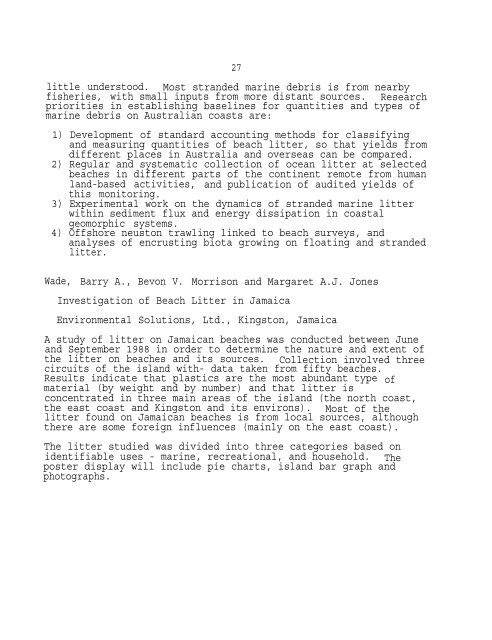Poster abstracts and manuscripts from the Third International ...
Poster abstracts and manuscripts from the Third International ...
Poster abstracts and manuscripts from the Third International ...
Create successful ePaper yourself
Turn your PDF publications into a flip-book with our unique Google optimized e-Paper software.
27<br />
little understood. Most str<strong>and</strong>ed marine debris is <strong>from</strong> nearby<br />
fisheries, with small inputs <strong>from</strong> more distant sources. Research<br />
priorities in establishing baselines for quantities <strong>and</strong> types of<br />
marine debris on Australian coasts are:<br />
1) Development of st<strong>and</strong>ard accounting methods for classifying<br />
<strong>and</strong> measuring quantities of beach litter, so that yields <strong>from</strong><br />
different places in Australia <strong>and</strong> overseas can be compared.<br />
2) Regular <strong>and</strong> systematic collection of ocean litter at selected<br />
beaches in different parts of <strong>the</strong> continent remote <strong>from</strong> human<br />
l<strong>and</strong>-based activities, <strong>and</strong> publication of audited yields of<br />
this monitoring.<br />
3) Experimental work on <strong>the</strong> dynamics of str<strong>and</strong>ed marine litter<br />
within sediment flux <strong>and</strong> energy dissipation in coastal<br />
geomorphic systems.<br />
4) Offshore neuston trawling linked to beach surveys, <strong>and</strong><br />
analyses of encrusting biota growing on floating <strong>and</strong> str<strong>and</strong>ed<br />
litter.<br />
Wade, Barry A., Bevon V. Morrison <strong>and</strong> Margaret A.J. Jones<br />
Investigation of Beach Litter in Jamaica<br />
Environmental Solutions, Ltd., Kingston, Jamaica<br />
A study of litter on Jamaican beaches was conducted between June<br />
<strong>and</strong> September 1988 in order to determine <strong>the</strong> nature <strong>and</strong> extent of<br />
<strong>the</strong> litter on beaches <strong>and</strong> its sources. Collection involved three<br />
circuits of <strong>the</strong> isl<strong>and</strong> with- data taken <strong>from</strong> fifty beaches.<br />
Results indicate that plastics are <strong>the</strong> most abundant type of<br />
material (by weight <strong>and</strong> by number) <strong>and</strong> that litter is<br />
concentrated in three main areas of <strong>the</strong> isl<strong>and</strong> (<strong>the</strong> north coast,<br />
<strong>the</strong> east coast <strong>and</strong> Kingston <strong>and</strong> its environs). Most of <strong>the</strong><br />
litter found on Jamaican beaches is <strong>from</strong> local sources, although<br />
<strong>the</strong>re are some foreign influences (mainly on <strong>the</strong> east coast).<br />
The litter studied was divided into three categories based on<br />
identifiable uses - marine, recreational, <strong>and</strong> household. The<br />
poster display will include pie charts, isl<strong>and</strong> bar graph <strong>and</strong><br />
photographs.
















